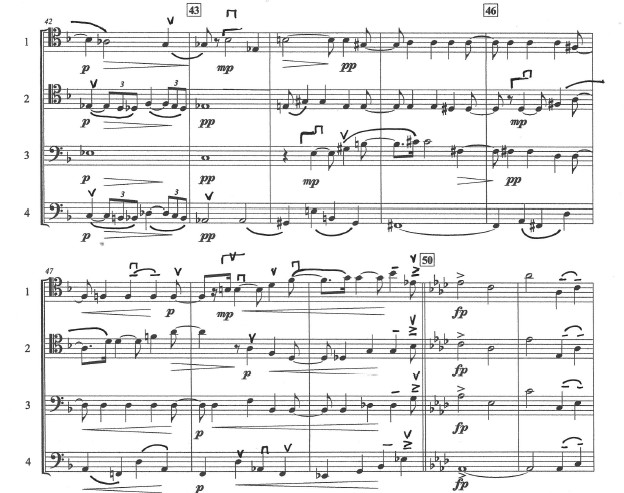WAGNER, Richard – ‘PARSIFAL MUSIC’ Piece No.3 – Finale of Act III – for FOUR Cello Soloists
- March 24, 2023
- 0 comments
- daib0

2,50€
Available in download/s with price: €3.50
The order is possible by credit card (minimum purchase €4.00) or by PayPal (minimum purchase €4.50)
There are generous discounts for larger orders (see information in the right column)
Please try not to enter more than a single copy of each work (with the quantity set to “1”, you already have 4 opportunities to download the requested PDFs, during a period of 7 days)
In each check-out the web shop can also include up to THREE free products together with your order (indicated with a price of €0.00) at your free choice!
In general, the most detailed descriptive information about the music offered is found in the English version of the website.
Enjoy the music!
Description
WAGNER, Richard – ‘PARSIFAL MUSIC’ Piece No.3 – Finale of Act III – for FOUR Cello Soloists
….
PDF 1 – General Score
PDF 2 – All Individual Cello Parts
….
EXAMPLES from the general score:


Notes:
Parsifal (WWV 111) is an opera or a music drama in three acts by the German composer Richard Wagner and was his last composition. In fact, Wagner himself described Parsifal not as an opera, but as Ein Bühnenweihfestspiel (a festival play for the consecration of the stage). His own libretto for the work is loosely based on the 13th-century Middle High German epic poem Parzival of the Minnesänger Wolfram von Eschenbach, recounting the story of the Arthurian knight Parzival (Percival) and his quest for the Holy Grail. Wagner conceived the idea of the grandiose work in April 1857, but he was not to finish it until 25 years later. In composing it he took advantage of the particular acoustics of his newly built Bayreuth Festspielhaus, and so Parsifal was first produced at the second Bayreuth Festival in 1882. The Bayreuth Festival maintained a monopoly on Parsifal productions until the earlier twentieth-century, when the opera was performed at the Metropolitan Opera in New York.
It is important to bear in mind that the musical arrangements for FOUR violoncellos are not exact transcriptions – this would be absolutely impossible for an orchestra including three flutes, three oboes, one cor anglais, three clarinets in B-flat and A, one bass clarinet in B-flat and A, three bassoons, one contrabassoon; four horns in F, three trumpets in F, three trombones, one tuba, 6 onstage trumpets in F, 6 onstage trombones; a percussion section that includes four timpani (requiring two players), tenor drums, 4 onstage church bells, one onstage thunder machine; two harps and strings! However, these cello presentations are made seriously enough for the themes and motives to resound with the public.
Prelude to Act 1 – the musical introduction to the work originally has a duration of somewhere between 12–16 minutes. The opening prelude introduces two important leitmotifs, generally referred to as the Communion theme and the theme of the Grail. These two, and Parsifal’s own motif, are repeated during the course of the opera [a leitmotif is a recurring musical theme within a particular piece of music, associated with a particular character, object, event or emotion]. Wagner is the composer most often associated with leitmotifs, and Parsifal makes liberal use of them, and many later composers used these ‘theories’.
Many music theorists have also used Parsifal to explore difficulties in analyzing the chromaticism of late 19th century music. The unusual harmonic progressions in the leitmotifs which structure the piece, as well as the heavy chromaticism of Act 2, make it a difficult work to get to grips with, musically. Additionally, and which is common in all mature Wagner operas, Parsifal was composed such that each act was a single unique continuous flow of music; hence there are no free-standing arias in the work where the public breaks off into applause. However, a number of orchestral excerpts from the opera were later arranged by Wagner himself, and still remain in the concert repertory. The prelude to Act 1 is perhaps the frequently performed.
The final five minutes of the opera Parsifal are totally transcendent — and, without doubt, worth the wait. Over the celestial sound of harps, we hear the motifs associated with the Grail and the Spear finally united in one ascending line, followed by the sound of the distant chorus, who sing the opera’s final line “Erlösung dem Erlöser” (Redemption to the Redeemer). In the shimmering last moments, the music goes through a vast array of keys — a long circle of fifths leads upwards, carrying the audience into exalted places. Finally, we arrive at Parsifal’s ultimate resolution, and have somehow ended up in the same key in which the opera began…
….
Resume of the FOUR CELLO presentations:
1 – Prelude to Act I {based on the transcription for winds by Boris Korolyov, and newly prepared for Cellos by David Johnstone}
2 – Fragment from Parsifal, made by Hermann Jacobowsky (unaltered by David Johnstone)
3 – Finale to the opera in a much-shortened version {based on the transcription for winds by Boris Korolyov, and newly prepared for Cellos by David Johnstone}
….
These may be performed as a group of pieces, following one from another….
estimated total performance duration of all music: about 20 minutes
ENGLISH
Welcome to Johnstone-Music! A big Anglo-Spanish web for MUSICIANS and especially CELLISTS – original music scores for orchestral instruments and keyboard. Plus articles, audios, videos, resources, catalogues, news etc. Official web of the professional cellist David Johnstone, principal cello Navarre Symphony Orchestra (Spain), chamber musician and soloist in many premieres. Hundreds of cello arrangements in the web for a symbolic charge per download or for free.
The following have taken his work onboard, sometimes with special collaborations as composer-arranger-performer: the Philadelphia Orchestra, Orquesta Sinfónica de Euskadi, Orquesta Sinfónica de Venezuela, Orchestre Nouvelle Generation de Montreal, the Gulbenkian Orchestra (Lisbon), Orchestra da Camera del Locarnese (Suiza), The Zagreb Soloists, the Saint Petersburg Musical Theatre “Zazerkalye” Chamber Orchestra, the Wroclaw Chamber Orchestra Leopoldinum (Poland), Auckland Philharmonic Orchestra (New Zealand), Camerata Cambrensis (Basque country), Ensemble Metamorphosis of Belgrade (Serbia), with Ara Malikian (Non Profit Music Chamber Orchestra – Madrid), and a long etc.. Currently, many courses, conservatoires and music schools, university String departments etc. use his repertoire; there are dozens of his arrangements on ‘You Tube’ …
Directly from the home page visit our sections:
** PHOTOS OF CELLO ENSEMBLES WORLD-WIDE PERFORMING SCORES FROM JOHNSTONE-MUSIC
** WHO PLAYS JOHNSTONE-MUSIC? – SEE EXTENSIVE LIST OF ORCHESTRAS, ORGANIZATIONS, EVENTS
.
.
Cellos Music Partituras gratis precio simbólico free symbolic price
Related products
-

JOHNSTONE – Softly, Silently – FOUR CELLOS
1,00€ Add to cart -

COOPER – Hoe-Down – CELLO ORCHESTRA (ideal for a young and large cello ensemble)
2,00€ Add to cart -

BACH J.S. – Air (from the Orchestral Suite No.3 ‘Air on the G String’) – FOUR CELLOS or larger cello ensemble
2,50€ Add to cart -

MOZART – Ave Verum Corpus – FOUR CELLOS
2,00€ Add to cart







